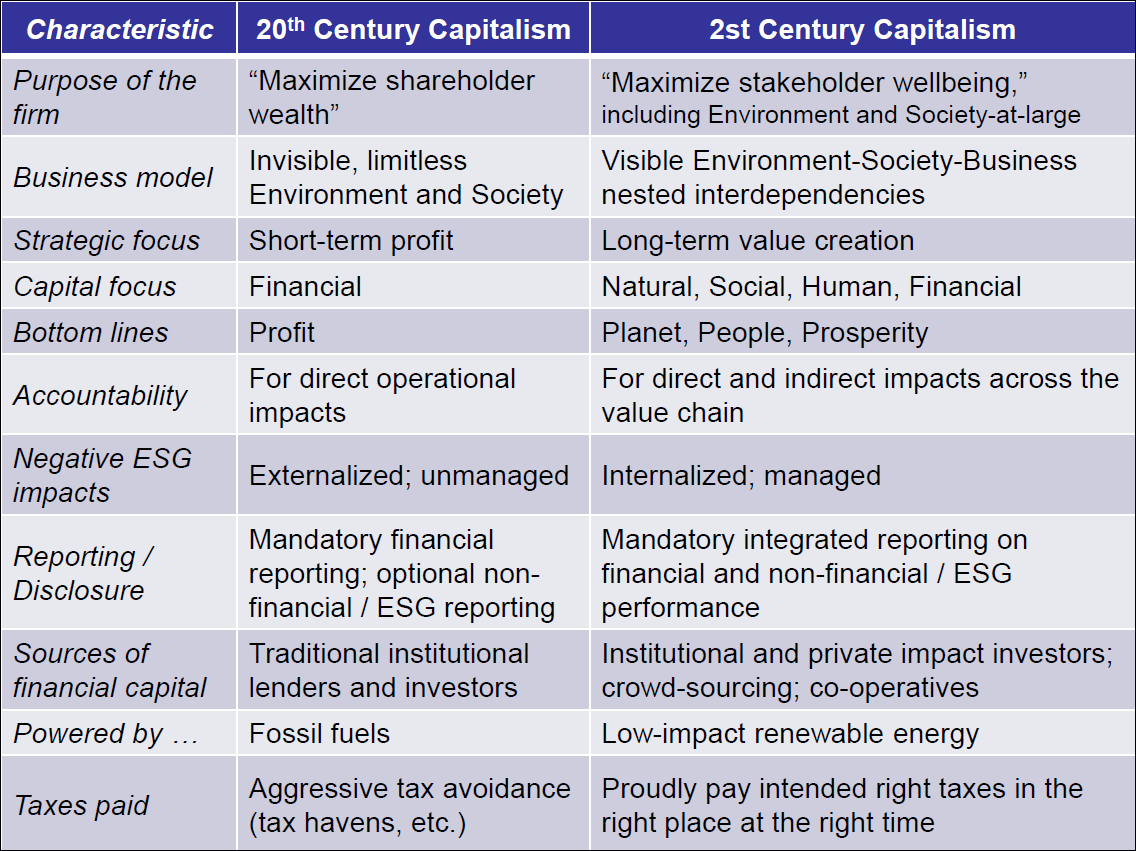New Stakeholder-centric Purpose Drives 21st Century Capitalism
For the last 50 years, Milton Friedman’s three-word corporate purpose mantra has been imprinted into the mindsets of business school graduates: “maximize shareholder wealth.” The maxim worked well … for the 1%. In August 2019, the Business Roundtable acknowledged that 20th century shareholder-primacy capitalism has failed the rest of us and declared that the new / improved 21st century corporate purpose is to “maximize stakeholder wellbeing.” Stakeholder-primacy capitalism is not a revelation for the founders of the B Corp movement who have shown that operating for the benefit of all stakeholders is more rewarding in today’s tumultuous economy. The new stakeholder-centric purpose drives 21st century capitalism – and changes everything.
20th century shareholder-primacy capitalism is a failed experiment
The purpose of shareholder-primacy capitalism is to maximize shareholder short-term wealth, even at the expense of other stakeholders. It rewards companies that privatize benefits and profits and socialize harms and losses. It encourages companies to relentlessly and unsustainably deplete our natural capital in pursuit of more and more profit and higher shareholder returns. Nature is resilient and self-regenerative, but there is an ecological tipping point beyond which it cannot recover from this abuse, as evidenced by the climate crisis. The same is true for society ‒ the widening gap between the have’s and have-not’s is unsustainable. Stakeholder-primacy capitalism has failed us.
21st century stakeholder-primacy capitalism is capitalism’s lifeline
The exciting purpose of stakeholder-primacy capitalism is to maximize stakeholders’ long-term wellbeing. Purpose drives everything. Once stakeholders ‒ like the environment, society-at-large, suppliers, customers, employees and communities ‒ have parity with shareholders, the company’s fiduciary duty includes stewardship of multiple capitals and intangible assets. To contribute to the environment’s and society-at-large’s wellbeing, the company helps address dangerous environmental issues like the climate crisis and dangerous buildups of waste. Paying taxes becomes a point of pride because tax revenues provide governments with the wherewithal to provide a social safety net and quality public services that contribute to the wellbeing of the community. The corporation reports on the progress it is making on non-financial as well as financial goals that will improve the wellbeing of a more inclusive mix of stakeholders.
This table compares the attributes of failed 20th century capitalism with fit-for-the-future 21st century capitalism. The top-line stakeholder-centric Purpose ‒ along with legitimizing the environment and society-at-large as key stakeholders ‒ drives all the other characteristics
21st century capitalism is the adult version of capitalism
So here’s the deal. It is high time we grew up, as a species. We’ve been acting like a spoiled child living off our parents’ / Mother Nature’s limited resources for too long. The shareholder-primacy purpose and business model assumed the planet’s resources were infinite and that limitless growth was a good thing. We’ve been drawing down our natural capital instead of living off its interest. Any financial planner knows that is unsustainable.
What to call the new capitalism
When we reinvent capitalism, what should we call it? “Stakeholder-primacy capitalism” may feel a bit cumbersome. There is no lack of other labels for a more environmentally and socially sustainable version of capitalism. Volans labels it “Breakthrough Capitalism;” Corporate Knights calls it “Clean Capitalism;” John Mackey and Raj Sesoria prefer “Conscious Capitalism;” Bill Gates used “Creative Capitalism” as the title of his book; Al Gore and David Blood call it “Sustainable Capitalism;” and Nicholas Shaxson uses “Responsible Capitalism.”
As a Certified B Corp and Future-Fit Designated Partner, I am equally comfortable with “B Corp” and “Future-Fit Corporation” labels. Todd Hendersin and Anup Malani called it “Capitalism 2.0″ in their March 2008 Forbes article with that title and I have used that label on occasion. As indicated by the headings in the above table, I’m now leaning toward the “21st Century Capitalism” label to imply that 20th Century Capitalism is defunct … because it is.
Anyway, does it really matter what the label is? As long as the corporation is driven by the “maximize stakeholder wellbeing” purpose and tracks, manages and reports on its progress on fulfilling that purpose, it can be called anything that resonates with its senior leadership. Maybe “Kick-ass Capitalism” would get their attention and reinforce that it is the winning formula for a thriving enterprise in the 21st century.
Regardless, we can no longer cling to our “global suicide pact,” as UN Secretary-General Ban Ki-Moon once labelled shareholder-primacy capitalism. 20th century shareholder-primacy capitalism has failed us; long live 21st century stakeholder-primacy capitalism.
This blog is an updated version of my May 2013 blog, “Capitalism 2.0,” which was what I am now calling “21st Century Capitalism” then. Same thing. As usual, the above table will be in the next quarterly release of my Master Slide Set.
Please feel free to add your comments and questions using the Comment link below. For email subscribers, please click here to visit my site and provide feedback.
Bob






Comments are closed.